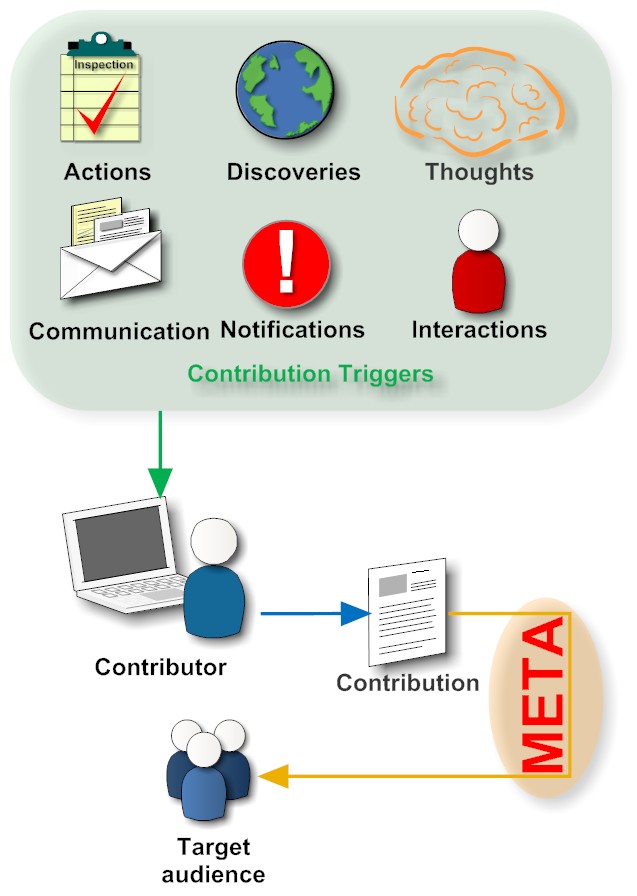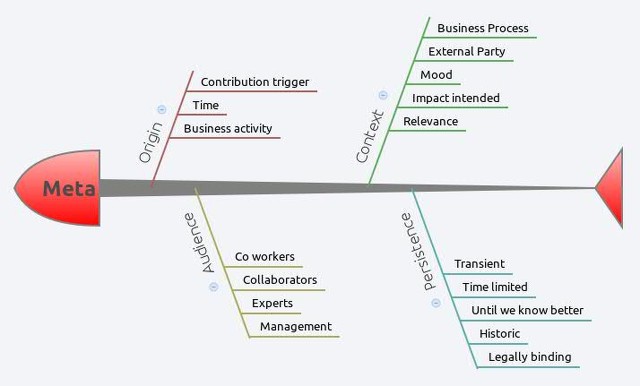Rethinking Social Software
Einstein is attributed with a famous quote: " Everything should be made as simple as possible, but no simpler." (called Einstein's razor, the counter balance to Occam's razor). Looking at the social software landscape today I must conclude that it is both too simple and not as simple as possible.
So something sharp is needed, lets get Occam and Einstein to work. Step 1 is to go meta and have a look how social collaboration contribution mechanics actually works:

Several triggers can induce a contribution to collaboration. The list of usual suspects include email, all known social tools, but also thoughts, business processes and face to face interactions. In summary: anything that is brought to or catches our attention. As technologist we gravitate toward the tool to classify the triggers, rather than the motivation behind them (as if it is more important how you arrived at the cinema that how good the movie is you are about to watch. Exactly here lie the adoption woes organisations face: bickering over tools instead of focus on intentions and outcome.
The interesting aspect in the illustration above is the word Meta. Thanks to friends who protect us the word Meta has gotten much deserved attention. I think a clever handling of meta information is the holy grail of social computing. Data today are commonly: date/time, author, tags (eventually), place of contribution (blog, wiki, Status update etc), size and supporting files (if any). However meta data goes further

There are 2 aspects that need to change in todays meta data - One: removal of the creator's burden to decide where to publish upfront, so (s)he can focus on the contribution. Two: the ability of the target audience to define more of that meta data as insights arise. IBM is on the trajectory to let the machine contribute to data and meta data too.
I advocated better sharing before, but I see more convergence and conversion needed:
As usual: YMMV
- In the "too simple" camp with have the notion: "everything is just one big stream of collaboration and a few tags will do" (and it's variations). If you follow this notion all collaboration you would ever need is a Twitter stream or a Whatsapp group.
- On the other hand "not simple enough" means: there are appropriate tools for every purpose: Blogs, micro-blogs, status updates, walls, file sharing, link sharing, activities, communities, team rooms, mailing lists, persistent chats and what have you
So something sharp is needed, lets get Occam and Einstein to work. Step 1 is to go meta and have a look how social collaboration contribution mechanics actually works:

Several triggers can induce a contribution to collaboration. The list of usual suspects include email, all known social tools, but also thoughts, business processes and face to face interactions. In summary: anything that is brought to or catches our attention. As technologist we gravitate toward the tool to classify the triggers, rather than the motivation behind them (as if it is more important how you arrived at the cinema that how good the movie is you are about to watch. Exactly here lie the adoption woes organisations face: bickering over tools instead of focus on intentions and outcome.
The interesting aspect in the illustration above is the word Meta. Thanks to friends who protect us the word Meta has gotten much deserved attention. I think a clever handling of meta information is the holy grail of social computing. Data today are commonly: date/time, author, tags (eventually), place of contribution (blog, wiki, Status update etc), size and supporting files (if any). However meta data goes further

There are 2 aspects that need to change in todays meta data - One: removal of the creator's burden to decide where to publish upfront, so (s)he can focus on the contribution. Two: the ability of the target audience to define more of that meta data as insights arise. IBM is on the trajectory to let the machine contribute to data and meta data too.
I advocated better sharing before, but I see more convergence and conversion needed:
- The "where" of a contribution is only an attribute, so I can "change" a blog entry into a WIKI by adding additional data (where in the Wiki page tree it should show)
- A Wiki can have a time line like a blog, there is no difference
- When I share a status update that contains a link, that link becomes a bookmark (unless I tell it not to)
- Readers of my contribution not only can comment or share my entry, but add meta data, including the ability to determine: this should be on this wiki page (as example)
- Flagging customers, people and processes
- A better overview with filters for my contribution
- Access to a shared and personal taxonomy
- ... there probably is more
As usual: YMMV
Posted by Stephan H Wissel on 01 March 2014 | Comments (0) | categories: SocialBusiness